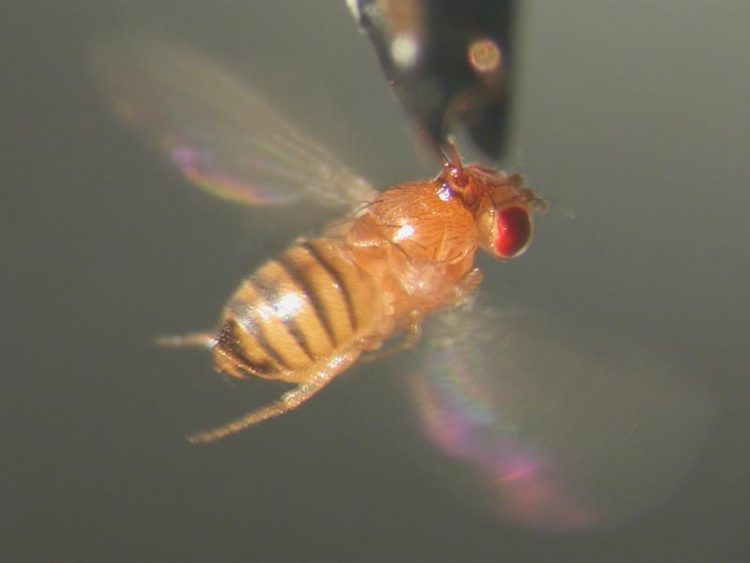Flies can tell us about the Origin of Language

Photograph of Drosophila
“Speaking any language requires proper articulation of the different sounds,” says Björn Brembs, Professor of Neurogenetics at Universität Regensburg, who coordinated the collaboration.
“To accomplish this feat, muscles in the lips, tongue and larynx need to work perfectly together. As toddlers, we acquire these skills by babbling until what we utter matches what we want to say,” adds Constance Scharff who has shown the relevance of FoxP for song learning in birds at the Freie Universität Berlin.
“Young songbirds try out different variants of sounds similarly to how infants babble”. Brembs and Scharff’s groups teamed up to study the role of FoxP in flies.
The researchers studied flies with genetically engineered FoxP in a learning experiment that comes as close to vocal learning as possible in a non-vocal animal. Similarly to infants and birds, the flies had to try out different movements with their flight muscles to learn where to fly and where not to fly.
Using a heat beam, the experimenters trained the flies to avoid flying towards one direction, forcing the fly to try different steering maneuvers. Flies with compromised FoxP genes failed in this task, while control flies did well. Importantly, the FoxP manipulated flies had no problem learning to avoid a particular direction when this was coupled to a color. The specificity of this deficit is also typical for patients with FOXP2 mutations.
“Also in line with the known function of FoxP in humans and birds is the observation that the morphology of certain sub-regions of the mutant flies’ brains is altered. This indicates that FoxP might regulate the expression of other genes during brain development,” says Jürgen Rybak from the Max Planck Institute for Chemical Ecology in Jena, who performed the morphological measurements of the fly brains.
These discoveries suggest that one of the roots of language can be placed 500 million years ago at the split between vertebrates and invertebrates, to an ancestor which had evolved the ability to learn by trial and error. From this, Troy Zars of the University of Missouri, Columbia concludes, “The identification of this phenotype in FoxP mutant flies provides a starting point in understanding the genes involved in trial-and-error-based learning and communication across species, and should help in understanding how genetic bases of communication deficits arise in humans.” Zars had discovered the FoxP gene in the fly genome in 2007.
“Presumably, the ability to learn from trial and error was harnessed when vocal learning in vertebrates and language acquisition in humans evolved,” Brembs surmises. The conservation of these functions opens the window for basic research into the genetic mechanisms underlying complex traits such as language or schizophrenia in animals that do not exhibit these traits – especially in genetically very accessible invertebrates such as Drosophila.
Further information:
http://brembs.net
Press Contact
Prof. Dr. Björn Brembs
Universität Regensburg
Institute for Zoology
Tel.: 0049 (0)941 943-3117
Bjoern.Brembs@ur.de
Media Contact
More Information:
http://www.uni-regensburg.de/All latest news from the category: Life Sciences and Chemistry
Articles and reports from the Life Sciences and chemistry area deal with applied and basic research into modern biology, chemistry and human medicine.
Valuable information can be found on a range of life sciences fields including bacteriology, biochemistry, bionics, bioinformatics, biophysics, biotechnology, genetics, geobotany, human biology, marine biology, microbiology, molecular biology, cellular biology, zoology, bioinorganic chemistry, microchemistry and environmental chemistry.
Newest articles

A universal framework for spatial biology
SpatialData is a freely accessible tool to unify and integrate data from different omics technologies accounting for spatial information, which can provide holistic insights into health and disease. Biological processes…

How complex biological processes arise
A $20 million grant from the U.S. National Science Foundation (NSF) will support the establishment and operation of the National Synthesis Center for Emergence in the Molecular and Cellular Sciences (NCEMS) at…

Airborne single-photon lidar system achieves high-resolution 3D imaging
Compact, low-power system opens doors for photon-efficient drone and satellite-based environmental monitoring and mapping. Researchers have developed a compact and lightweight single-photon airborne lidar system that can acquire high-resolution 3D…





















